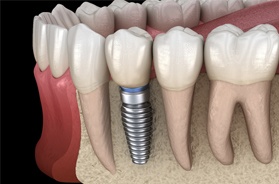
Bone Augmentation – Torrington, CT
Prepare Your Jaw to Support Dental Implants
One of the essential requirements for dental implants is that a patient possesses adequate bone density and height in their jaw to support the implants. If the bone is not large enough or strong enough, the implants may fail to bond with it. If, however, during your dental implant consultation, our team determines that your bone cannot support dental implants, that does not necessarily bar you from receiving them. Following a bone augmentation procedure, you may be able to avail yourself of all the benefits of implant-supported tooth replacement.
Why Choose Torrington Dental Care for Bone Augmentation?
- All-inclusive dental implant care
- Experienced implant dentist
- Prepare your mouth to support long-lasting, reliable tooth replacement
What Is Bone Augmentation?

Bone augmentation, sometimes called a bone graft, is a surgical procedure wherein extra bone material gets added to the bone that will support dental implants. The new material bonds with the existing bone, thus making it strong enough and big enough to work well with dental implants.
There are a number of different types of bone grafting procedures. In some cases, a bit of bone from another part of the patient’s own body may be used. In other cases, artificial or donor bone is used. The area of the mouth where the bone augmentation takes place, as well as the amount of new bone needed, also affect the specifics of the procedure.
Why Might I Need Bone Augmentation?

There are a number of factors that might lead to the need for bone augmentation:
- Bone deterioration following tooth loss. After you lose a natural tooth, the bone that once supported it immediately begins to be resorbed. That is to say, the body recycles the bone material for other purposes. Hence, the longer it has been since you lost your natural teeth, the greater the possibility that you will require bone augmentation.
- Gum disease. Gum disease does more than destroy the soft tissue around your teeth. It also attacks the jawbone. Therefore, even if you no longer have active gum disease, you may already have lost enough bone because of it to require a bone graft.
- Natural structural issues. If the natural structure of your jaw will not provide adequate support for your dental implants, bone augmentation might be necessary.
What Can I Expect from Bone Augmentation?

When you speak to the dentist about your upcoming dental implant journey, he will let you know whether you need bone augmentation. He will also explain the specifics of the surgery and help you prepare for it.
If your bone augmentation treatment will be fairly minor, it is possible that it will take place at the same time as your dental implant placement surgery. However, it is also possible that you will need a separate surgery for bone augmentation. Following bone augmentation, you may have to wait a few months while the grafted material bonds with your body before you can receive dental implants.
Would you like to learn more about dental implants and bone augmentation? Contact Torrington Dental Care today.